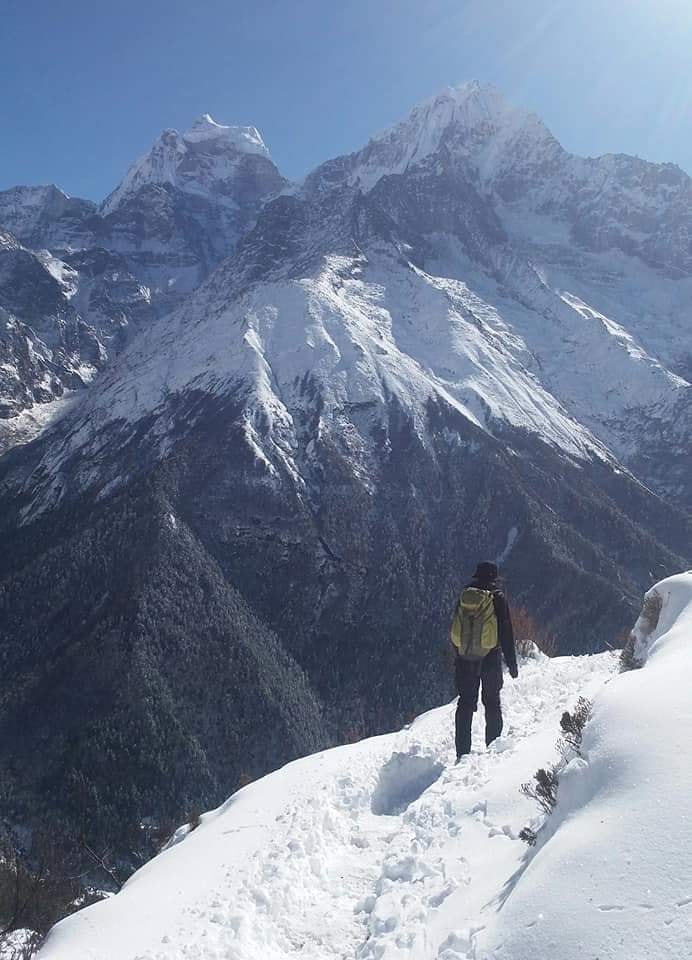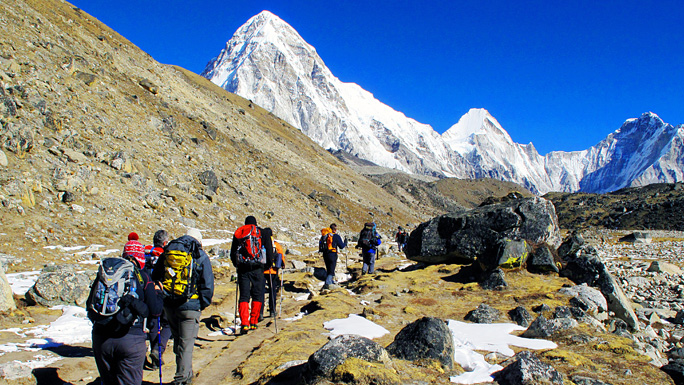The Everest Base Camp trek tops the bucket list of any adventure seeker, be it a hiker or a mountaineer. It is one of the most popular trekking activities in Nepal. Anyone who is planning to trek starts researching months in advance to get their body and mind ready for the adventure. If you are planning a trek to Everest Base Camp, we have compiled a list of 5 questions frequently asked by trekkers planning for the Everest Base Camp trek and answered those.

What is the best time of the year for the trek?
While you can trek throughout the year in Nepal, the season you choose has a strong impact on the trekking experience. The rainy monsoon is set apart by muddy and slippery trails infested with leeches and not-so-great mountain views. On the other hand, winters can get very cold; you can tackle it by packing the right gear. On the bright side, you can avoid the crowd if you choose to trek during winter months.
Spring (from March to May) and autumn (from September to November) are typically the two best trekking seasons. During spring, you will not only have warm temperatures but will also have a visual treat of the rhododendron-filled landscapes and clear blue skies. In autumn, weather conditions are stable and pleasant; you are in for stunning mountain and forest views. If you choose to trek during these peak seasons, you can also expect the camp to be busy and alive with other trekkers.
How should I train for the trek?
Some people get deterred by the magnitude of the trek to Everest Base Camp. However, the trek is achievable provided you are in good physical condition. If you read reviews on the Internet, take it with a pinch of salt. The trek might be easy for someone who has trained for months but not for someone who is unfit. Make sure you read up on their itinerary, lodging, and how they prepared for the trek.
Typically, a round trip to Everest Base Camp takes 12 to 15 days depending upon the trekking agency or package you choose. Generally, it is recommended to:
Start training 8–12 weeks before the trek.
Practice long walks on uneven or hilly terrains.
Hike for 5–6 hours with minimal breaks.
Get used to wearing backpacks during the hikes.
Improve cardiovascular endurance through aerobic activities.
Do strength training.
It is always important to check with your doctor before starting any training program. Also, research the trekking route that suits your current level of fitness so that you have a comfortable trekking experience.
Is it difficult to acclimatize?
When it comes to Everest Base Camp Trek, altitude sickness is one of the physical conditions that trekkers fear. You suffer from it when your body cannot adjust to low oxygen levels and low air pressure at high altitudes. When it hits you, the symptoms can range from nausea and headache to shortness of breath. As an extreme form of this, you may experience acute mountain sickness.
During the Everest Base Camp trek, you will be starting from around 2600m and reach a height of approximately 5500m, which can vary according to the package you choose, before descending. However, most tour operators factor in a day or two for acclimatizing at certain altitudes because the time spent at high altitudes can give you an edge on acclimatizing. To tackle the sickness on your trek, you can climb slowly and stay hydrated throughout the trek; taking prescribed medications can also reduce the symptoms. Remember everybody reacts differently to altitude. Though descending to a lower altitude improves the situation, you might still be determined to finish the trek. Regularly speak with your guide about your symptoms; they can help you tackle the situation better.
What are the facilities available during the trek?
Since trekking to Everest Base Camp is attempted by many trekkers from all over the world, the popularity has made more and more facilities available to the trekkers. Although these are the general facilities available during the trek, you can talk to your trekking agency to understand the specific facilities covered for the cost you paid for the trek.
Food and Accommodation – Since Everest Base Camp treks are tea house treks, you do not have to worry about food or water. You can get good food and accommodation in the tea houses that are dotted along the route.
Communication – If you buy a SIM card with a data plan, you can use the mobile Internet along the popular trekking routes. Alternatively, you can also use Wi-Fi available for sale in tea houses. There are also telephones in villages located along the routes.
Porter – If you are worried about completing the trek, let alone hauling the entire luggage, fear not. You can employ a porter to carry your luggage.
How to choose the right trekking agency?
When you plan for a trek to Everest Base Camp, it is important to choose a trekking agency that has been officially recognized. A company that has been leading successful treks for several years will help you have a memorable experience. You can learn a lot of information and tackle trekking better if you are traveling with a knowledgeable trekking guide. Read reviews to know about the crew and how well they handle medical emergencies. You also have to keep in mind how much an Everest Base Camp trek costs while choosing the agency; reading up on what is included in the cost will help you pack appropriately for the trek.
Everything from the season, your fitness level, and the trekking agency that you choose can alter your trekking experience. Hopefully, the article helped you understand the essential things that will help you undertake the trek.
